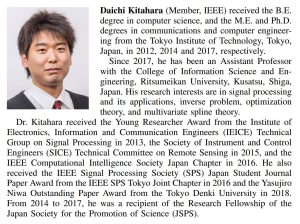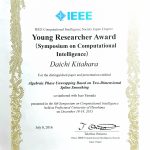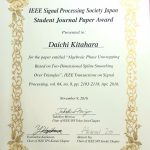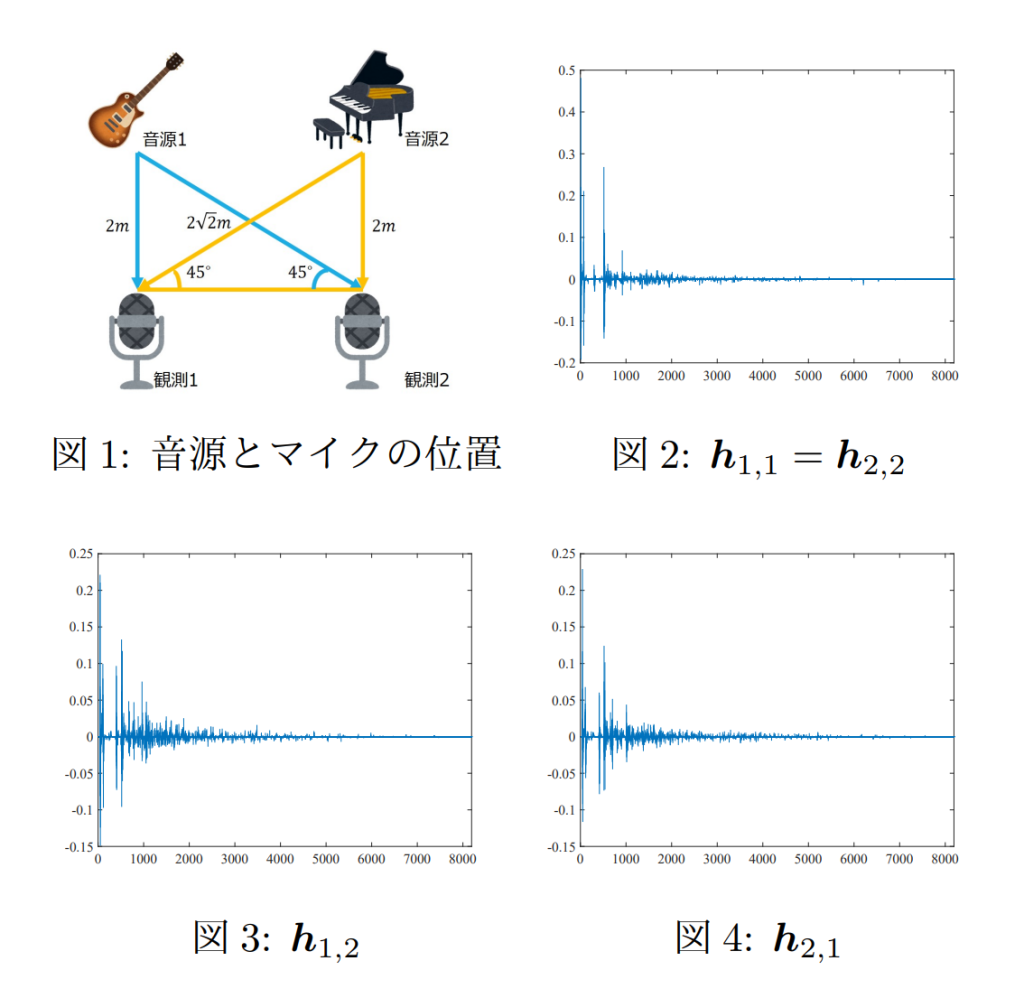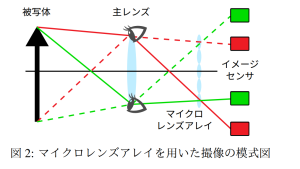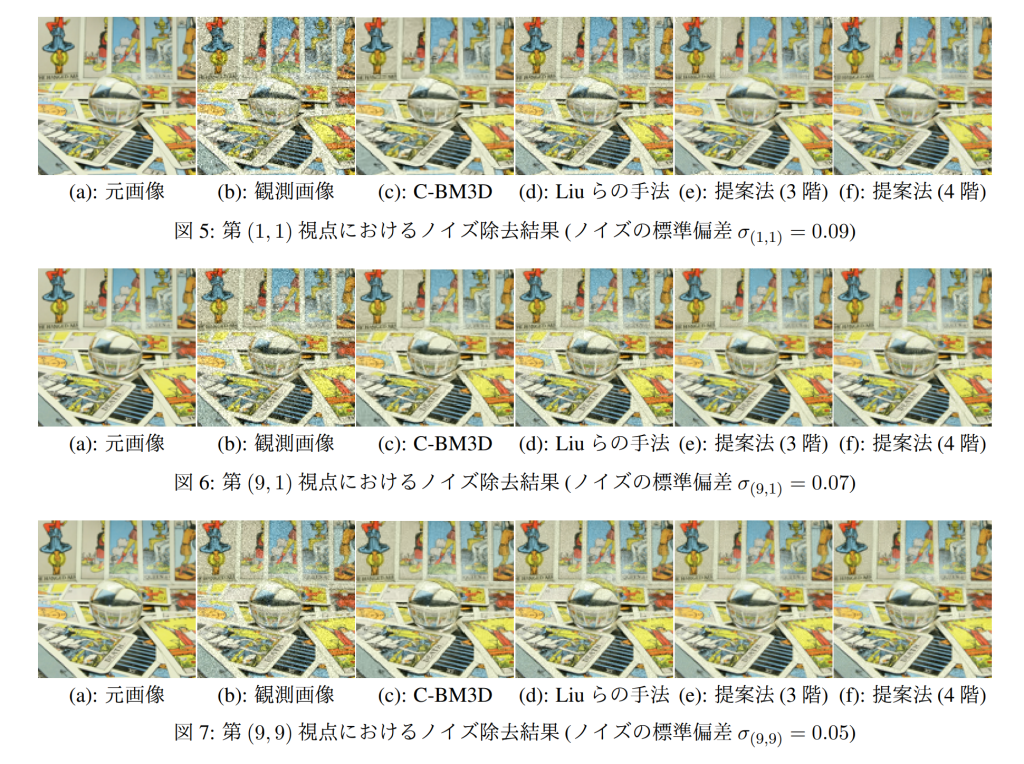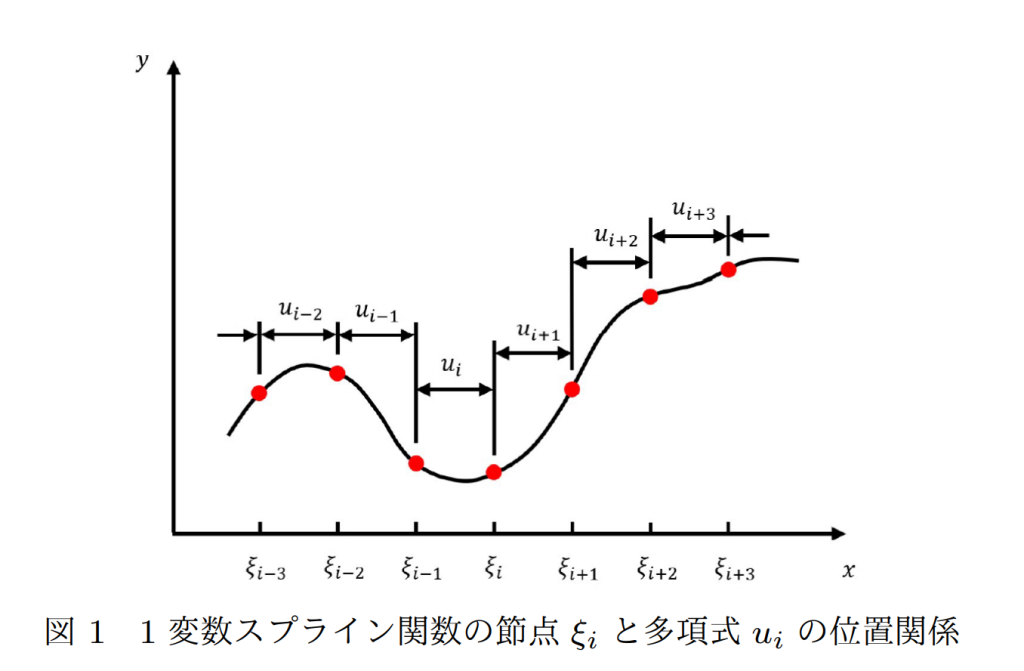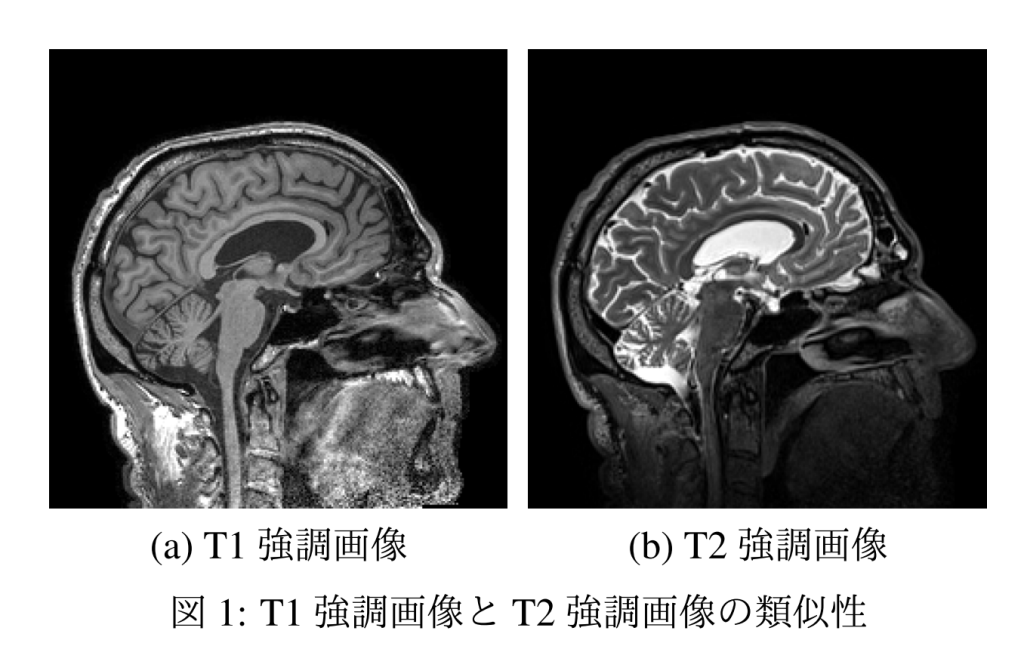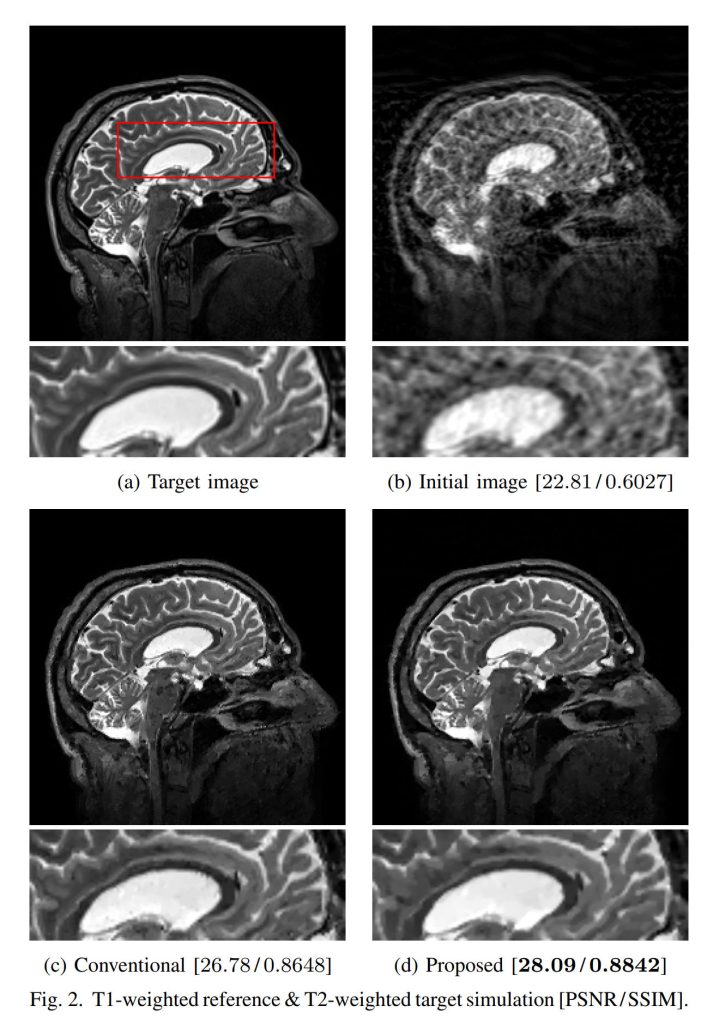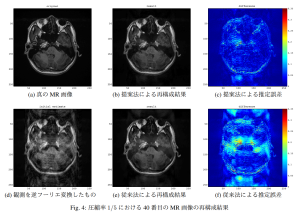Preprints / Submitted
D. Kitahara and K. Yatabe,
“Design of tight minimum-sidelobe windows by Riemannian Newton’s method,”
preprint arXiv:2111.01593, 5 pages, 2021.
[Signal Processing Theory and Methods, Audio Signal Processing, Nonconvex Optimization]
D. Kitahara,
“Frequency-undersampled short-time Fourier transform,”
preprint arXiv:2010.15029, 5 pages, 2020.
[Signal Processing Theory and Methods, Audio Signal Processing, Others]
Journal Papers
[2023]
H. Kuroda, D. Kitahara, E. Yoshikawa, H. Kikuchi, and T. Ushio,
“Convex estimation of sparse-smooth power spectral densities from mixtures of realizations with application to weather radar,”
IEEE Access, vol. 11, pp. 128859–128874, Nov. 2023.
[Signal Processing Theory and Methods, Radar Signal Processing, Convex Optimization] official access
L. Condat, D. Kitahara, A. Contreras, and A. Hirabayashi,
“Proximal splitting algorithms for convex optimization: A tour of recent advances, with new twists,”
SIAM Review, vol. 65, no. 2, pp. 375–435, May 2023.
[Signal Processing Theory and Methods, Convex Optimization] official access / pdf (preprint)
S. Yao, D. Kitahara, H. Kuroda, and A. Hirabayashi,
“Modal interval regression based on spline quantile regression,”
IEICE Transactions on Fundamentals of Electronics, Communications and Computer Sciences, vol. E106-A, no. 2, pp. 106–123, Feb. 2023.
[Signal Processing Theory and Methods, Data Analysis, Spline Smoothing, Convex Optimization] official access / pdf (preprint)
[2022]
北原 大地,
“区分的多項式とスプライン関数の基礎—折れ線グラフを曲線にしてみよう—,”
日本音響学会誌, vol. 78, no. 10, pp. 570–577, Oct. 2022.
[Signal Processing Theory and Methods, Spline Smoothing] official access / pdf (preprint)
H. Yamamoto, D. Kitahara, H. Kuroda, and A. Hirabayashi,
“Image super-resolution via generative adversarial networks using metric projections onto consistent sets for low-resolution inputs,”
IEICE Transactions on Fundamentals of Electronics, Communications and Computer Sciences, vol. E105-A, no. 4, pp. 704–718, Apr. 2022.
[Image Processing, Machine Learning] official access / pdf (preprint)
D. Kitahara, H. Kuroda, A. Hirabayashi, E. Yoshikawa, H. Kikuchi, and T. Ushio,
“Nonlinear beamforming based on group-sparsities of periodograms for phased array weather radar,”
IEEE Transactions on Geoscience and Remote Sensing, vol. 60, 19 pages, Mar. 2022.
[Signal Processing Theory and Methods, Radar Signal Processing, Convex Optimization] official access / pdf (preprint)
H. Kuroda and D. Kitahara,
“Block-sparse recovery with optimal block partition,”
IEEE Transactions on Signal Processing, vol. 70, pp. 1506–1520, Mar. 2022.
[Signal Processing Theory and Methods, Radar Signal Processing, Audio Signal Processing, Convex Optimization] official access / pdf (preprint)
[2021]
K. Yoshimoto, H. Kuroda, D. Kitahara, and A. Hirabayashi,
“WaveNet modeling of distortion pedal using spectral features,”
Acoustical Science and Technology, vol. 42, no. 6, pp. 305–313, Nov. 2021.
[Audio Signal Processing, Machine Learning] official access / pdf
H. Kamoshita, D. Kitahara, K. Fujimoto, L. Condat, and A. Hirabayashi,
“Multiclass dictionary-based statistical iterative reconstruction for low-dose CT,”
IEICE Transactions on Fundamentals of Electronics, Communications and Computer Sciences, vol. E104-A, no. 4, pp. 702–713, Apr. 2021.
[Medical Image Processing, Nonconvex Optimization] official access / pdf (preprint)
[2020]
R. Kawami, D. Kitahara, A. Hirabayashi, E. Yoshikawa, H. Kikuchi, and T. Ushio,
“Three-dimensional data compression and fast high-quality reconstruction for phased array weather radar,”
IEEJ Transactions on Electronics, Information and Systems, vol. 140, no. 1, pp. 40–48, Jan. 2020.
[Radar Signal Processing, Convex Optimization] official access / pdf (preprint)
[2017]
平林 晃, 北原 大地,
“圧縮センシングの基礎と画像取得への応用,”
光学, vol. 46, no. 10, pp. 393–397, Oct. 2017.
[Image Processing, Medical Image Processing, Convex Optimization, Nonconvex Optimization] official access / pdf (preprint)
[2016]
D. Kitahara and I. Yamada,
“Algebraic phase unwrapping based on two-dimensional spline smoothing over triangles,”
IEEE Transactions on Signal Processing, vol. 64, no. 8, pp. 2103–2118, Apr. 2016.
[Signal Processing Theory and Methods, Radar Signal Processing, Polynomial Algebra, Spline Smoothing, Convex Optimization] official access / pdf (preprint)
[2015]
D. Kitahara and I. Yamada,
“Algebraic phase unwrapping along the real axis: extensions and stabilizations,”
Multidimensional Systems and Signal Processing, vol. 26, no. 1, pp. 3–45, Jan. 2015.
[Signal Processing Theory and Methods, Polynomial Algebra] official access / pdf (preprint)
国際学会/International Conferences
[2023]
H. Kuroda, D. Kitahara, E. Yoshikawa, H. Kikuchi, and T. Ushio,
“Sparsity-smoothness-aware power spectral density estimation with application to phased array weather radar,”
IEEE International Conference on Acoustics, Speech and Signal Processing (ICASSP), Rhodes Island, Greece, Jun. 2023, to appear.
[Signal Processing Theory and Methods, Radar Signal Processing, Convex Optimization]
[2022]
H. Kuroda and D. Kitahara,
“Graph-structured sparse regularization via convex optimization,”
IEEE International Conference on Acoustics, Speech and Signal Processing (ICASSP), Singapore, May 2022, pp. 5538–5542.
[Signal Processing Theory and Methods, Convex Optimization] official access
[2021]
D. Kitahara, R. Kato, H. Kuroda, and A. Hirabayashi,
“Multi-contrast CSMRI using common edge structures with LiGME model,”
European Signal Processing Conference (EUSIPCO), Dublin, Ireland, Aug. 2021, pp. 2119–2123.
[Medical Image Processing, Convex Optimization] official access / pdf (preprint)
H. Kuroda, D. Kitahara, and A. Hirabayashi,
“A convex penalty for block-sparse signals with unknown structures,”
IEEE International Conference on Acoustics, Speech and Signal Processing (ICASSP), Toronto, Canada, Jun. 2021, pp. 5430–5434.
[Signal Processing Theory and Methods, Radar Signal Processing, Audio Signal Processing, Convex Optimization] official access / pdf
[2020]
K. Yoshimoto, H. Kuroda, D. Kitahara, and A. Hirabayashi,
“Deep neural network modeling of distortion stomp box using spectral features,”
Asia-Pacific Signal and Information Processing Association Annual Summit and Conference (APSIPA ASC), Auckland, New Zealand, Dec. 2020, pp. 339–345.
[Audio Signal Processing, Machine Learning] official access / pdf (preprint)
D. Kitahara, K. Leng, Y. Tezuka, and A. Hirabayashi,
“Simultaneous spline quantile regression under shape constraints,”
European Signal Processing Conference (EUSIPCO), Amsterdam, Netherlands, Oct. 2020, pp. 2423–2427.
[Signal Processing Theory and Methods, Data Analysis, Spline Smoothing, Convex Optimization] official access / pdf (preprint)
H. Yamamoto, D. Kitahara, and A. Hirabayashi,
“Image super-resolution via generative adversarial network using an orthogonal projection,”
European Signal Processing Conference (EUSIPCO), Amsterdam, Netherlands, Oct. 2020, pp. 660–664.
[Image Processing, Machine Learning] official access / pdf (preprint)
R. Nakatsu, D. Kitahara, and A. Hirabayashi,
“Non-Griffin–Lim type signal recovery from magnitude spectrogram,”
IEEE International Conference on Acoustics, Speech and Signal Processing (ICASSP), Barcelona, Spain, May 2020, pp. 791–795.
[Signal Processing Theory and Methods, Audio Signal Processing, Nonconvex Optimization] official access / pdf (preprint)
Y. Takahashi, D. Kitahara, K. Matsuura, and A. Hirabayashi,
“Determined source separation using the sparsity of impulse responses,”
IEEE International Conference on Acoustics, Speech and Signal Processing (ICASSP), Barcelona, Spain, May 2020, pp. 686–690.
[Audio Signal Processing, Nonconvex Optimization] official access / pdf (preprint)
[2019]
S. Ananda, D. Kitahara, A. Hirabayashi, and K. R. U. K. Reddy,
“Automatic fundus image segmentation for diabetic retinopathy diagnosis by multiple modified U-Nets and SegNets,”
Asia-Pacific Signal and Information Processing Association Annual Summit and Conference (APSIPA ASC), Lanzhou, China, Nov. 2019, pp. 1582–1588.
[Medical Image Processing, Machine Learning] official access / pdf (preprint)
D. Kitahara, S. Ananda, and A. Hirabayashi,
“Optimization-based fundus image decomposition for diagnosis support of diabetic retinopathy,”
Asia-Pacific Signal and Information Processing Association Annual Summit and Conference (APSIPA ASC), Lanzhou, China, Nov. 2019, pp. 1565–1572.
[Medical Image Processing, Convex Optimization] official access / pdf (preprint)
H. Kamoshita, T. Shibata, D. Kitahara, K. Fujimoto, and A. Hirabayashi,
“Low-dose CT reconstruction with multiclass orthogonal dictionaries,”
IEEE International Conference on Image Processing (ICIP), Taipei, Taiwan, Sep. 2019, pp. 2055–2059.
[Medical Image Processing, Nonconvex Optimization] official access / pdf (preprint)
D. Kitahara, L. Condat, and A. Hirabayashi,
“One-dimensional edge-preserving spline smoothing for estimation of piecewise smooth functions,”
IEEE International Conference on Acoustics, Speech and Signal Processing (ICASSP), Brighton, UK, May 2019, pp. 5611–5615.
[Signal Processing Theory and Methods, Spline Smoothing, Convex Optimization] official access / pdf (preprint)
L. Condat, D. Kitahara, and A. Hirabayashi,
“A convex lifting approach to image phase unwrapping,”
IEEE International Conference on Acoustics, Speech and Signal Processing (ICASSP), Brighton, UK, May 2019, pp. 1852–1856.
[Signal Processing Theory and Methods, Image Processing, Medical Image Processing, Radar Signal Processing, Convex Optimization] official access / pdf
[2018]
D. Kitahara, M. Nakahara, A. Hirabayashi, E. Yoshikawa, H. Kikuchi, and T. Ushio,
“Nonlinear beamforming via convex optimization for phased array weather radar,”
Asia-Pacific Signal and Information Processing Association Annual Summit and Conference (APSIPA ASC), Honolulu, HI, USA, Nov. 2018, pp. 1831–1835.
[Radar Signal Processing, Convex Optimization] official access / pdf (preprint)
D. Kitahara and I. Yamada,
“A branch cut algorithm for 180-degree ambiguity resolution in 2D vector fields and its application to single-frame fringe projection profilometry,”
Asia-Pacific Signal and Information Processing Association Annual Summit and Conference (APSIPA ASC), Honolulu, HI, USA, Nov. 2018, pp. 122–128.
[Signal Processing Theory and Methods, Image Processing, Combinatorial Optimization] official access / pdf (preprint)
[2017]
R. Kawami, H. Kataoka, D. Kitahara, A. Hirabayashi, T. Ijiri, S. Shimamura, H. Kikuchi, and T. Ushio,
“Fast high-quality three-dimensional reconstruction from compressive observation of phased array weather radar,”
Asia-Pacific Signal and Information Processing Association Annual Summit and Conference (APSIPA ASC), Kuala Lumpur, Malaysia, Dec. 2017, pp. 44–49.
[Radar Signal Processing, Convex Optimization] official access / pdf (preprint)
D. Kitahara and I. Yamada,
“Algebraic phase unwrapping with self-reciprocal polynomial algebra,”
International Conference on Sampling Theory and Applications (SampTA), Tallinn, Estonia, Jul. 2017, pp. 350–354.
[Signal Processing Theory and Methods, Polynomial Algebra] official access / pdf (preprint)
[2016]
M. Yamagishi, D. Kitahara, and I. Yamada,
“A fast dual iterative algorithm for convexly constrained spline smoothing,”
IEEE International Conference on Acoustics, Speech and Signal Processing (ICASSP), Shanghai, China, Mar. 2016, pp. 4538–4542.
[Signal Processing Theory and Methods, Spline Smoothing, Convex Optimization] official access / pdf
D. Kitahara and I. Yamada,
“Two-dimensional positive spline smoothing and its application to probability density estimation,”
IEEE International Conference on Acoustics, Speech and Signal Processing (ICASSP), Shanghai, China, Mar. 2016, pp. 4219–4223.
[Signal Processing Theory and Methods, Data Analysis, Spline Smoothing, Convex Optimization] official access / pdf (preprint)
K. Kakimoto, D. Kitahara, M. Yamagishi, and I. Yamada,
“Stabilization of adaptive eigenvector extraction by continuation in nested orthogonal complement structure,”
IEEE International Conference on Acoustics, Speech and Signal Processing (ICASSP), Shanghai, China, Mar. 2016, pp. 4189–4193.
[Signal Processing Theory and Methods, Others] official access / pdf
[2015]
D. Kitahara, M. Yamagishi, and I. Yamada,
“A virtual resampling technique for algebraic two-dimensional phase unwrapping,”
IEEE International Conference on Acoustics, Speech and Signal Processing (ICASSP), Brisbane, Australia, Apr. 2015, pp. 3871–3875.
[Signal Processing Theory and Methods, Radar Signal Processing, Convex Optimization] official access / pdf (preprint)
D. Kitahara and I. Yamada,
“Probability density function estimation by positive quartic C2-spline functions,”
IEEE International Conference on Acoustics, Speech and Signal Processing (ICASSP), Brisbane, Australia, Apr. 2015, pp. 3556–3560.
[Signal Processing Theory and Methods, Data Analysis, Spline Smoothing, Convex Optimization] official access / pdf (preprint)
[2014]
D. Kitahara and I. Yamada,
“Algebraic phase unwrapping over collection of triangles based on two-dimensional spline smoothing,”
IEEE International Conference on Acoustics, Speech and Signal Processing (ICASSP), Florence, Italy, May 2014, pp. 4963–4967.
[Signal Processing Theory and Methods, Radar Signal Processing, Polynomial Algebra, Spline Smoothing, Convex Optimization] official access / pdf (preprint)
[2013]
D. Kitahara and I. Yamada,
“Algebraic phase unwrapping for functional data analytic estimations—extensions and stabilizations,”
IEEE International Conference on Acoustics, Speech and Signal Processing (ICASSP), Vancouver, Canada, May 2013, pp. 5835–5839.
[Signal Processing Theory and Methods, Polynomial Algebra] official access / pdf (preprint)
国内学会/Domestic Conferences
[2022]
H. Kuroda, D. Kitahara, E. Yoshikawa, H. Kikuchi, and T. Ushio,
“Sparsity and smoothness regularized estimation of power spectral density and its application to weather radar,”
第37回信号処理シンポジウム, 新潟, Dec. 2022, pp. 113–117.
[Signal Processing Theory and Methods, Radar Signal Processing, Convex Optimization] pdf
D. K. Kim, P. Baron, K. Kawashima, D. Kitahara, T. Mega, Y. Wada, and T. Ushio,
日本気象学会2022年度秋季大会, 札幌, Oct. 2022, 1 page, to appear.
[Radar Signal Processing, Machine Learning]
川島 康平, 北原 大地, 金 東均, 妻鹿 友昭, 和田 有希, 牛尾 知雄, Philippe Baron, 吉川 栄一, 林 修吾, 菊池 博史,
日本気象学会2022年度秋季大会, 札幌, Oct. 2022, 1 page, to appear.
[Radar Signal Processing, Machine Learning]
D. Kitahara and K. Yatabe,
“Design of tight minimum-sidelobe windows by Newton’s method on oblique manifolds for time-frequency domain signal processing,”
日本応用数理学会2022年度年会, 札幌, Sep. 2022, 2 pages.
[Signal Processing Theory and Methods, Audio Signal Processing, Nonconvex Optimization] pdf (preprint)
少路 春希, 吉本 健人, 阪 大樹, 黒田 大貴, 北原 大地, 田中 賢一郎, 平林 晃,
“ファインチューニングを利用した歪みエフェクタの高速モデリング,”
電子情報通信学会信号処理研究会, 那覇, Mar. 2022, vol. 121, no. 384, pp. 70–75.
[Audio Signal Processing, Machine Learning] official access / pdf (preprint)
[2021]
H. Kuroda and D. Kitahara,
“Exploiting graph-structured sparsity via convex optimization,”
第36回信号処理シンポジウム, Online, Nov. 2021, pp. 92–95.
[Signal Processing Theory and Methods, Convex Optimization] pdf
[2020]
H. Kuroda, D. Kitahara, and A. Hirabayashi,
“Recovery of block-sparse signals with optimization of block partitions,”
第35回信号処理シンポジウム, 高知, Nov. 2020, pp. 123–124.
[Signal Processing Theory and Methods, Convex Optimization] pdf
北原 大地, 加藤 里佳子, 黒田 大貴, 平林 晃,
“エッジ情報とLiGMEモデルを用いたマルチコントラスト圧縮センシングMRI,”
第35回信号処理シンポジウム, 高知, Nov. 2020, pp. 95–100.
[Medical Image Processing, Convex Optimization] pdf (preprint)
北原 大地,
“周波数間引き短時間フーリエ変換の提案,”
第35回信号処理シンポジウム, 高知, Nov. 2020, pp. 11–16.
[Signal Processing Theory and Methods, Audio Signal Processing, Others] pdf (preprint)
北原 大地,
“スプライン関数の基礎と分位点回帰への応用,”
電子情報通信学会信号処理研究会, Online, Aug. 2020, vol. 120, no. 142, pp. 37–42. (招待講演)
[Signal Processing Theory and Methods, Data Analysis, Spline Smoothing, Convex Optimization] official access / pdf (preprint)
北原 大地, 小川 佳瑚, 金銅 美陽, 平林 晃,
“4階テンソル構造を利用したライトフィールドノイズ除去,”
第33回回路とシステムワークショップ, 岐阜, Aug. 2020, pp. 41–46.
[Image Processing, Nonconvex Optimization] pdf (preprint)
滝本 健人, 北原 大地, 平林 晃, 牛尾 知雄,
“フェーズドアレイ気象レーダのための時空間的特徴を利用した高精度ビームフォーミング,”
2020年電子情報通信学会総合大会, 東広島, Mar. 2020, p. 73.
[Radar Signal Processing, Convex Optimization] pdf (preprint)
吉本 健人, 北原 大地, 平林 晃,
“スペクトル特徴量を利用した深層学習による歪みエフェクタの高精度モデリング,”
電子情報通信学会信号処理研究会, 那覇, Mar. 2020, vol. 119, no. 440, pp. 135–140.
[Audio Signal Processing, Machine Learning] official access / pdf
[2019]
D. Kitahara, K. Leng, Y. Tezuka, and A. Hirabayashi,
“Functional data analysis between two random variables by multilevel monotone splines,”
第34回信号処理シンポジウム, 鳥取, Nov. 2019, pp. 248–251.
[Signal Processing Theory and Methods, Data Analysis, Spline Smoothing, Convex Optimization] pdf (preprint)
中津 龍星, 北原 大地, 平林 晃,
“振幅スペクトログラムからの非Griffin–Lim型音源信号復元手法,”
第34回信号処理シンポジウム, 鳥取, Nov. 2019, pp. 162–165.
[Signal Processing Theory and Methods, Audio Signal Processing, Nonconvex Optimization] pdf (preprint)
松浦 功一郎, 平林 晃, 北原 大地,
“マルチトラック楽曲におけるGANを用いた大楽節の自動生成,”
日本音響学会2019年秋季研究発表会, 草津, Sep. 2019, pp. 1147–1150.
[Audio Signal Processing, Machine Learning] pdf
髙橋 悠希, 北原 大地, 平林 晃,
“インパルス応答のスパース性を用いた教師あり独立低ランク行列分析,”
日本音響学会2019年秋季研究発表会, 草津, Sep. 2019, pp. 291–294.
[Audio Signal Processing, Nonconvex Optimization] pdf (preprint)
北原 大地, 森川 侑奈, 平林 晃, 吉川 栄一, 菊池 博史, 牛尾 知雄,
“フェーズドアレイレーダにおける隣接仰角間の類似性を利用した気象パラメータ推定,”
第32回回路とシステムワークショップ, 東京, Aug. 2019, pp. 129–134.
[Radar Signal Processing, Nonconvex Optimization] pdf (preprint)
北原 大地, 手塚 祐司, 関根 理, 冷 可, 姚 賽, 東 長佳, 山本 有香子, 小林 純, 鷲山 美樹, 巖西 真規, 平林 晃, 柏木 厚典,
“2型糖尿病患者における性差を考慮したBMIと残余リスクの管理状況の関係,”
第62回日本糖尿病学会年次学術集会, 仙台, May 2019, 1 page.
[Data Analysis, Statistical Hypothesis Testing]
山本 宏哉, 北原 大地, 平林 晃,
“客観品質を考慮した敵対的生成ネットワークによる画像超解像,”
電子情報通信学会信号処理研究会, 長崎, Mar. 2019, vol. 118, no. 496, pp. 93–98.
[Image Processing, Machine Learning] official access / pdf (preprint)
中本 和磨, 藤井 皓介, 北原 大地, 平林 晃,
“2種類の辞書とBCCB行列の対角化を利用したMR画像再構成,”
電子情報通信学会信号処理研究会, 長崎, Mar. 2019, vol. 118, no. 496, pp. 75–80.
[Medical Image Processing, Nonconvex Optimization] official access / pdf (preprint)
[2018]
川見 亮介, 北原 大地, 平林 晃, 吉川 栄一, 菊池 博史, 牛尾 知雄,
“フェーズドアレイ気象レーダのデータ圧縮と3階テンソル辞書学習を用いた高精度再構成,”
第33回信号処理シンポジウム, 東京, Nov. 2018, pp. 227–228.
[Radar Signal Processing, Nonconvex Optimization] pdf (preprint)
藤井 皓介, 中田 和希, 北原 大地, 平林 晃,
“2種類の直交辞書を用いたMR画像高精度再構成,”
第33回信号処理シンポジウム, 東京, Nov. 2018, pp. 219–224.
[Medical Image Processing, Nonconvex Optimization] pdf (preprint)
D. Kitahara, L. Condat, and A. Hirabayashi,
“1D piecewise smooth function estimation with spline functions,”
第33回信号処理シンポジウム, 東京, Nov. 2018, pp. 154–157.
[Signal Processing Theory and Methods, Spline Smoothing, Convex Optimization] pdf (preprint)
D. Kitahara, A. Hirabayashi, E. Yoshikawa, H. Kikuchi, and T. Ushio,
“Nonlinear beamforming based on group sparsity for phased array weather radar,”
第33回信号処理シンポジウム, 東京, Nov. 2018, pp. 148–153.
[Radar Signal Processing, Convex Optimization] pdf (preprint)
冷 可, 姚 賽, 荒木 はなこ, 北原 大地, 平林 晃, 伊波 早苗, 手塚 祐司, 巌西 真規, 柏木 厚典,
“湖南地域における2型糖尿病患者の特性の解明―肥満と2型糖尿病管理について―,”
第55回日本糖尿病学会近畿地方会, 神戸, Oct. 2018, 1 page.
[Data Analysis, Statistical Hypothesis Testing]
北原 大地, 杉浦 紫緒里, 平林 晃,
“量子化された符号化撮像からの高精度ライトフィールド再構成,”
第24回画像センシングシンポジウム, 横浜, Jun. 2018, 7 pages.
[Image Processing, Convex Optimization] pdf (preprint)
鴨下 飛竜, 北原 大地, 平林 晃,
“マルチクラス辞書学習を用いた低線量CT画像再構成,”
電子情報通信学会信号処理研究会, 岐阜, May 2018, vol. 118, no. 33, pp. 63–68.
[Medical Image Processing, Nonconvex Optimization] official access / pdf (preprint)
北原 大地, 小田 亮太, 平林 晃,
“混合過程推定にスパース性を利用したブラインド音源分離,”
第62回システム制御情報学会研究発表講演会, 京都, May 2018, 7 pages.
[Audio Signal Processing, Nonconvex Optimization] pdf (preprint)
馬場 敦之, 片岡 秀公, 北原 大地, 平林 晃,
“直交射影層を用いた畳み込みニューラルネットワークによる画像超解像,”
電子情報通信学会信号処理研究会, 石垣, Mar. 2018, vol. 117, no. 516, pp. 347–352.
[Image Processing, Machine Learning] official access / pdf (preprint)
小田 亮太, 北原 大地, 平林 晃,
“インパルス応答のスパース性を利用したブラインド音源分離,”
電子情報通信学会信号処理研究会, 石垣, Mar. 2018, vol. 117, no. 516, pp. 341–346.
[Audio Signal Processing, Nonconvex Optimization] official access / pdf (preprint)
[2017]
柴田 基, 北原 大地, 平林 晃,
“レベル集合制約を用いた圧縮センシングMRI,”
第8回横幹連合コンファレンス, 京都, Dec. 2017, 6 pages.
[Medical Image Processing, Convex Optimization] official access / pdf (preprint)
柴田 基, 北原 大地, 平林 晃,
“圧縮サンプリングからのパラメータ設定に頑健なMR画像再構成法,”
第32回信号処理シンポジウム, 盛岡, Nov. 2017, pp. 105–110.
[Medical Image Processing, Convex Optimization] pdf (preprint)
D. Kitahara and I. Yamada,
“A stabilization of algebraic phase unwrapping along the unit circle with self-reciprocal subresultant,”
2017年電子情報通信学会総合大会, 名古屋, Mar. 2017, p. 101.
[Signal Processing Theory and Methods, Polynomial Algebra] pdf (preprint)
[2016]
森 和也, 北原 大地, 山岸 昌夫, 山田 功,
“Huber損失関数を用いたロバストな三重位相差型GPS,”
第31回信号処理シンポジウム, 吹田, Nov. 2016, pp. 427–432.
[Radar Signal Processing, Convex Optimization] pdf (preprint)
D. Kitahara and I. Yamada,
“A branch cut type sign estimator for single-frame fringe projection profilometry,”
第31回信号処理シンポジウム, 吹田, Nov. 2016, pp. 157–161.
[Signal Processing Theory and Methods, Image Processing, Combinatorial Optimization] pdf (preprint)
山田 功, 北原 大地,
“位相をつなぐ―代数的位相アンラップとその応用,”
2016年電子情報通信学会ソサイエティ大会, 札幌, Sep. 2016, pp. SS14–SS15. (招待講演)
[Signal Processing Theory and Methods, Polynomial Algebra] official access / pdf
D. Kitahara and I. Yamada,
“A branch cut type sign estimator for 3D measurement from a single fringe pattern,”
第9回コンピューテーショナル・インテリジェンス研究会, 千葉, Jul. 2016, pp. 73–76.
[Signal Processing Theory and Methods, Image Processing, Combinatorial Optimization] official access / pdf (preprint)
[2015]
D. Kitahara and I. Yamada,
“Algebraic phase unwrapping based on two-dimensional spline smoothing,”
第8回コンピューテーショナル・インテリジェンス研究会, 広島, Dec. 2015, pp. 11–18.
[Signal Processing Theory and Methods, Radar Signal Processing, Polynomial Algebra, Spline Smoothing, Convex Optimization] official access / pdf (preprint)
D. Kitahara and I. Yamada,
“Two-dimensional phase unwrapping based on selective smoothing and inconsistency correction,”
第30回信号処理シンポジウム, いわき, Nov. 2015, pp. 361–366.
[Signal Processing Theory and Methods, Radar Signal Processing, Convex Optimization] pdf (preprint)
D. Kitahara and I. Yamada,
“Positive quartic and biquartic C2-splines and their applications to two-dimensional probability density estimation,”
第30回信号処理シンポジウム, いわき, Nov. 2015, pp. 344–349.
[Signal Processing Theory and Methods, Data Analysis, Spline Smoothing, Convex Optimization] pdf (preprint)
K. Kakimoto, D. Kitahara, M. Yamagishi, and I. Yamada,
“On a projection step by generalized orthogonal complement matrices for adaptive subspace tracking,”
第30回信号処理シンポジウム, いわき, Nov. 2015, pp. 328–331.
[Signal Processing Theory and Methods, Others] pdf
D. Kitahara and I. Yamada,
“A smoothness-aware phase unwrapping by convex optimization technique,”
第40回リモートセンシングシンポジウム, 東京, Mar. 2015, pp. 1–2.
[Signal Processing Theory and Methods, Radar Signal Processing, Convex Optimization] pdf (preprint)
[2014]
D. Kitahara and I. Yamada,
“One-dimensional probability density function estimation by positive quartic C2-spline interpolation and smoothing,”
第29回信号処理シンポジウム, 京都, Nov. 2014, pp. 462–467.
[Signal Processing Theory and Methods, Data Analysis, Spline Smoothing, Convex Optimization] pdf (preprint)
D. Kitahara, M. Yamagishi, and I. Yamada,
“A preprocessing using convex optimization for algebraic two-dimensional phase unwrapping,”
第29回信号処理シンポジウム, 京都, Nov. 2014, pp. 369–374.
[Signal Processing Theory and Methods, Radar Signal Processing, Convex Optimization] pdf (preprint)
M. Yamagishi, D. Kitahara, and I. Yamada,
“A fast Gauss–Seidel-like splitting algorithm for convexly constrained spline smoothing,”
第29回信号処理シンポジウム, 京都, Nov. 2014, pp. 64–67.
[Signal Processing Theory and Methods, Spline Smoothing, Convex Optimization] pdf
北原 大地,
“二次元位相アンラップ問題の難しさと面白さ,”
第29回信号処理シンポジウム, 京都, Nov. 2014. (チュートリアル講演)
[Signal Processing Theory and Methods, Combinatorial Optimization]
[2013]
D. Kitahara and I. Yamada,
“Algebraic phase unwrapping over collection of triangles and its application,”
第28回信号処理シンポジウム, 下関, Nov. 2013, pp. 355–358.
[Signal Processing Theory and Methods, Radar Signal Processing, Polynomial Algebra, Spline Smoothing] pdf (preprint)
[2012]
D. Kitahara and I. Yamada,
“A stabilization of algebraic phase unwrapping by subresultant,”
第27回信号処理シンポジウム, 石垣, Nov. 2012, pp. 484–488.
[Signal Processing Theory and Methods, Polynomial Algebra] pdf (preprint)
D. Kitahara and I. Yamada,
“A robust algebraic phase unwrapping based on spline approximation,”
電子情報通信学会信号処理研究会, 京都, Jul. 2012, vol. 112, no. 115, pp. 1–6.
[Signal Processing Theory and Methods, Polynomial Algebra, Spline Smoothing] official access / pdf (preprint)
D. Kitahara and I. Yamada,
“Mixed trigonometric interpolation techniques for fast and stable algebraic phase unwrapping,”
電子情報通信学会信号処理研究会, 新潟, Mar. 2012, vol. 111, no. 466, pp. 303–307.
[Signal Processing Theory and Methods, Others] official access / pdf (preprint)
[2011]
D. Kitahara and I. Yamada,
“A stable sign estimation for algebraic phase unwrapping,”
第26回信号処理シンポジウム, 札幌, Nov. 2011, pp. 562–565.
[Signal Processing Theory and Methods, Others] pdf (preprint)
